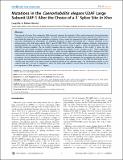Mutations in the Caenorhabditis elegans U2AF Large Subunit UAF-1 Al= of a 3' Splice Site In Vivo
Author(s)
Ma, Long; Horvitz, Howard Robert
DownloadMa-2009-Mutations in the Cae.pdf (632.8Kb)
PUBLISHER_CC
Publisher with Creative Commons License
Creative Commons Attribution
Terms of use
Metadata
Show full item recordAbstract
The removal of introns from eukaryotic RNA transcripts requires the activities of five multi-component ribonucleoprotein complexes and numerous associated proteins. The lack of mutations affecting splicing factors essential for animal survival has limited the study of the in vivo regulation of splicing. From a screen for suppressors of the Caenorhabditis elegans unc-93(e1500) rubberband Unc phenotype, we identified mutations in genes that encode the C. elegans orthologs of two splicing factors, the U2AF large subunit (UAF-1) and SF1/BBP (SFA-1). The uaf-1(n4588) mutation resulted in temperature-sensitive lethality and caused the unc-93 RNA transcript to be spliced using a cryptic 3′ splice site generated by the unc-93(e1500) missense mutation. The sfa-1(n4562) mutation did not cause the utilization of this cryptic 3′ splice site. We isolated four uaf-1(n4588) intragenic suppressors that restored the viability of uaf-1 mutants at 25°C. These suppressors differentially affected the recognition of the cryptic 3′ splice site and implicated a small region of UAF-1 between the U2AF small subunit-interaction domain and the first RNA recognition motif in affecting the choice of 3′ splice site. We constructed a reporter for unc-93 splicing and using site-directed mutagenesis found that the position of the cryptic splice site affects its recognition. We also identified nucleotides of the endogenous 3′ splice site important for recognition by wild-type UAF-1. Our genetic and molecular analyses suggested that the phenotypic suppression of the unc-93(e1500) Unc phenotype by uaf-1(n4588) and sfa-1(n4562) was likely caused by altered splicing of an unknown gene. Our observations provide in vivo evidence that UAF-1 can act in regulating 3′ splice-site choice and establish a system that can be used to investigate the in vivo regulation of RNA splicing in C. elegans.
Date issued
2009-11Department
Massachusetts Institute of Technology. Department of BiologyJournal
PLoS Genetics
Publisher
Public Library of Science
Citation
Ma, Long, and H. Robert Horvitz. “Mutations in the Caenorhabditis elegans U2AF Large Subunit UAF-1 Alter the Choice of a 3′ Splice Site In Vivo.” PLoS Genet 5.11 (2009): e1000708.
Version: Final published version
ISSN
1553-7390
1553-7404